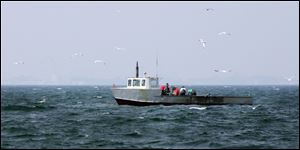
Fishing on Lake Erie becomes a bit harder
Fuel price, algae, and catch cut will be felt
3/26/2011
Members of the commercial fishing and charter boat industries say fuel costs and Lake Erie's algae have affected their businesses.
But those aren't the only factors coming into play for 2011. Catch limits call for at least 4 percent fewer yellow perch to be harvested from Lake Erie while allowing nearly a third more walleye to be taken, according to figures announced yesterday by a five-member board of fishery managers.
Called simply the Lake Erie Committee, the board — which consists of one voting member each from Michigan, Ohio, New York, Pennsylvania, and Ontario — has the unenviable task of trying to keep a diverse group of fishermen from the United States and Canada happy.
Most U.S. fishermen using Lake Erie are sportsmen casting a rod from a bridge, a shoreline, or a pleasure boat in hopes of catching its two most prized fish, yellow perch and walleye, one fish at a time.
Most fish taken from the lake's Canadian side are caught by trawl nets dropped by crews of fishermen employed by a commercial business that serves restaurants and retail supermarkets.
Invariably, there is a clash of cultures and objectives, with each lake committee trying to keep the resource from being exploited. For Lake Erie, yellow perch and walleye are the only two species with lake-wide catch limits.
Although a Lake Erie Committee task force estimates the lake now has 130 million yellow perch, or 28 percent fewer than 2010, the board has agreed to reduce the 2011 catch limit by only 4 percent, from 13.1 million to 12.6 million.
The board also agreed to increase the catch limit for walleye by 33 percent, from 2.2 million fish in 2010 to 2.9 million this year, in part because of the maturation of an "exceptional" 2003 hatch and another solid one in 2007.
Even so, today's estimated Lake Erie walleye population of 21.2 million walleye is well short of the 1980s-era peak of 70 million to 80 million. Many fish biologists have said those peak numbers, though, were anomalies.
The limits are established annually after a series of complex biological data and mathematical formulas are exhaustively negotiated among members of each lake committee, which has one vote from every state and province bordering each particular body of water.
"They talked mostly about the strength of recruitment and year classes," Marc Gaden, spokesman for the Ann Arbor-based Great Lakes Fishery Commission, said.
Frank Reynolds of Oregon, who holds one of Ohio's few remaining commercial fishing licenses, said algae and fuel costs kept him from hitting his limit last fall.
"The green algae really gave it to us good," he said. "You just can't catch [yellow] perch in dirty nets. It was so green out there we had to really go all the way to the Canadian line. It hurt us."
Paul Pacholski of Toledo, the Lake Erie Charter Boat Association's 2010 charter boat captain of the year, said it likewise hurt his business.
A second annual gathering of Lake Erie's top phosphorus researchers is scheduled for Monday at the University of Toledo's Lake Erie Center. Phosphorus is a fertilizer that helps algae grow. It has been on the rise in Lake Erie's western basin annually since 1995, as has algae.
"It's a big problem," said Roger Knight, an Ohio Department of Natural Resources biologist who serves as the state's Lake Erie fisheries manager and is its lone vote on the Lake Erie Committee. "It could be affecting fishery performance and the ability to reproduce."
Last year's actual catch of yellow perch was 9.69 million pounds, or 74 percent of the catch limit. The walleye harvest was 2 million fish, or 91 percent of the catch limit.
Mr. Knight said the phosphorus-algae problem is "not anecdotal or irrelevant."
The Great Lakes has a fishery with a combined value estimated at $7 billion, with $1 billion of that economic impact being in Ohio alone.
Contact Tom Henry at: thenry@theblade.com or 419-724-6079.